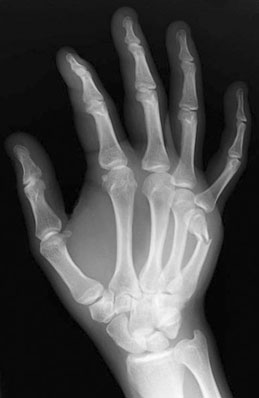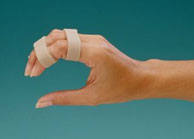Boxers Fracture
 What is a boxer fracture?
What is a boxer fracture?
A Boxer's fracture is a break of the metacarpal of the little or ring finger. The metacarpals are the long bones in the hand that connect the fingers to the wrist. A boxer's fracture refers to a break at the end of the bone nearest to the knuckle, which is called a metacarpal neck.
Why have I got a boxers fracture?
This type of fracture most commonly occurs when someone punches a hard surface or another person with a closed fist. Since most people punch in a round-house fashion the first point of bony contact in a punch is the little finger metacarpal bone. The force concentrates at the mid carpal neck, leading to a fracture. Ironically, this is a rare injury in boxers, because they are trained to punch with even force over the entire hand, maximising force and minimising injury. A boxer's fracture can also occur when a person stumbles and tries to break his fall with a closed fist to the ground. Occasionally, direct trauma to the hand can also cause this injury.
How do I know If I have a fracture?
Common symptoms include pain, tenderness and swelling around the knuckle of the little finger. Bruising and loss of knuckle contour are also common and extending the finger may be difficult. In severely displaced fractures the fingers may overlap or scissor when they are flexed.
What is the treatment?
 Most boxer's fractures can be treated with neighbour strapping to stabilise the fracture while it heals. Neighbour strapping is the term to describe using some sticky tape to strap the broken finger to the neighbouring intact finger. Even when the fracture is angled and the hand looks deformed it is usually sufficient to treat in this way, as there is no loss of function in the hand and surgery can give worse results than leaving it.
Most boxer's fractures can be treated with neighbour strapping to stabilise the fracture while it heals. Neighbour strapping is the term to describe using some sticky tape to strap the broken finger to the neighbouring intact finger. Even when the fracture is angled and the hand looks deformed it is usually sufficient to treat in this way, as there is no loss of function in the hand and surgery can give worse results than leaving it.
If the knuckle is severely deformed or the fracture is further down the bone (nearer the wrist) a procedure called a closed reduction may be needed to push the fracture back into proper position before a plaster cast is applied. For severe displacement, finger scissoring or multiple metacarpal fractures surgery may be recommended. If the fracture is angled by more than 60 degrees it may result in a tender palmar mass with heavy gripping. Though quite unusual, fracture rotation is an indication for surgical intervention.
Surgery for metacarpal fractures.
This can be done under a local anaesthetic/ nerve block or general anaesthetic. The fracture is reduced back into the right position and a wire is inserted up the middle of the bone. This acts like an internal splint, holding the fracture in an acceptable position while it heals. If there is rotation of the finger other wires may be inserted across the hand. These wires stay in place for 4 weeks.
What should I expect after the surgery?
 Local anaesthetic will be injected into the wound at the end of the operation. This area will remain numb for up to six hours after surgery. Before the effect wears off, you should take painkillers which should be taken on a regular basis. Swelling causes stiffness and pain which is made worse by hanging the arm down at your side or resting it on your lap. Swelling is best prevented by keeping the hand above the level of the heart for the first 48 hours. It is also important to keep the fingers moving through a full range of motion, including the rest of the joints in the finger which has been injured.
Local anaesthetic will be injected into the wound at the end of the operation. This area will remain numb for up to six hours after surgery. Before the effect wears off, you should take painkillers which should be taken on a regular basis. Swelling causes stiffness and pain which is made worse by hanging the arm down at your side or resting it on your lap. Swelling is best prevented by keeping the hand above the level of the heart for the first 48 hours. It is also important to keep the fingers moving through a full range of motion, including the rest of the joints in the finger which has been injured.
Your plaster will be removed at 2 weeks and the wound checked. Your stitches are absorbable so they will not need to be removed. The wires which are holding the fracture poke out of the skin. These will have to be kept clean and dry until the wires are removed in the clinic at 4 weeks. It is natural to be concerned that it will be painful when the wires are out in the clinic, but it is surprisingly pain free and very easily done.
Can anything go wrong?
Operations to fix hand fractures using wires or plates are very successful. Most people who have them are delighted with the operation and are glad they had it done. Like any operation a very small number of people can have a problem. The main problem is infection, this will present as redness around the wound or wire site and should be treated with antibiotics. If it is particularly troublesome strong antibiotics are given into vain and all the metal will have to be removed. Nerves can be bruised and the fingers can become stiff. The risks of these problems only add up to 2-3% of all operations but need to be taken into account when deciding whether to have the operation. You should discuss the possibility of problems with your surgeon before your operation
When can I return to driving and work?
The hand will protected by a splint so return to sedentary jobs which can be done with one hand is possible after a few days, as long as the hand is held elevated in a sling. Heavy manual work especially gripping and hammering will take about 8 weeks, however this will vary according to the type of fracture and how well it has healed on x-ray appearances. After two weeks you can usually drive a car as long as you are comfortable and have regained full finger movements.



